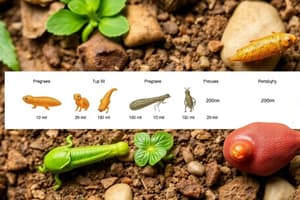Podcast
Questions and Answers
What is the main characteristic that defines living organisms?
What is the main characteristic that defines living organisms?
- Growth
- Responsiveness
- Metabolism (correct)
- Homeostasis
Which function refers to the ability of living organisms to maintain a stable internal environment?
Which function refers to the ability of living organisms to maintain a stable internal environment?
- Growth
- Homeostasis (correct)
- Reproduction
- Metabolism
What characteristic involves living organisms increasing in size and complexity?
What characteristic involves living organisms increasing in size and complexity?
- Adaptation
- Responsiveness
- Reproduction
- Growth (correct)
Which ability do living organisms possess to adapt to their environment?
Which ability do living organisms possess to adapt to their environment?
What is the term for the process of living organisms converting energy to sustain their activities?
What is the term for the process of living organisms converting energy to sustain their activities?
How do living organisms respond to external stimuli?
How do living organisms respond to external stimuli?
What are the two varieties of cells mentioned in the text?
What are the two varieties of cells mentioned in the text?
Which of the following is NOT classified as a Kingdom according to the text?
Which of the following is NOT classified as a Kingdom according to the text?
Why is biodiversity important according to the text?
Why is biodiversity important according to the text?
Which category refines the classification of living organisms further within a Phylum?
Which category refines the classification of living organisms further within a Phylum?
What do prokaryotic cells lack that eukaryotic cells have?
What do prokaryotic cells lack that eukaryotic cells have?
What threats do living organisms face due to human activities according to the text?
What threats do living organisms face due to human activities according to the text?
Flashcards are hidden until you start studying
Study Notes
Understanding Living Organisms
Living organisms are the foundational building blocks of life on our planet. They possess the unique ability to grow, reproduce, respond to their environment, and maintain a balance of chemical processes within themselves. Let's dive deeper into the fascinating world of living organisms and their characteristics.
Defining Life
Life is a complex concept that has intrigued and confounded scientists for centuries. Generally speaking, living organisms are defined by their ability to perform certain functions, including:
- Metabolism: Living organisms convert energy from their environment to sustain their activities and grow.
- Homeostasis: They maintain a stable internal environment to survive.
- Growth: Living organisms increase in size and complexity.
- Reproduction: They produce new offspring capable of reproducing themselves.
- Responsiveness: Living organisms respond to external stimuli and adapt to their environment.
- Adaptation: They can undergo changes over time to better survive in their environment.
The Universal Tree of Life
Living organisms can be divided into six kingdoms based on their cell structure, mode of nutrition, and genetic makeup. The "tree of life" illustrates these relationships visually, as shown below:

From complex, multicellular organisms like humans and plants to the tiniest single-celled organisms, the tree of life connects all living beings.
Cellular Organization
Cells are the smallest units of life and come in two varieties: prokaryotic cells (found in bacteria and archaea) and eukaryotic cells (found in animals, plants, fungi, and protists). Eukaryotic cells have a nucleus and membrane-bound organelles for specialized functions, while prokaryotic cells have neither a nucleus nor membrane-bound organelles.
Classification of Living Organisms
Living organisms can be classified according to several criteria:
- Domain: Kingdom Animalia (animals), Kingdom Plantae (plants), Kingdom Fungi (fungi), Kingdom Monera (bacteria), and Kingdom Archaea (archaea).
- Kingdom: Animals, plants, fungi, protists, and monerans (bacteria and archaea).
- Phylum: Animals, for example, have phyla such as Chordata (vertebrates) and Insecta (insects), while plants have phyla like Magnoliophyta (flowering plants).
- Class: Classes like Mammalia (mammals) and Liliopsida (monocots) represent distinct groups within phyla.
- Order, Family, Genus, and Species: These categories further refine the classification of living organisms.
Diversity of Living Organisms
The biodiversity of living organisms is truly astounding, with an estimated 1.5 million known species on Earth. However, many more species are thought to remain undiscovered. The diversity of living organisms is essential for maintaining the health and balance of our planet's ecosystems.
Threats to Living Organisms
Unfortunately, many living organisms face threats from human activities, including habitat destruction, pollution, and climate change. These threats can lead to species extinction, causing imbalances in ecosystems and negatively impacting the natural world.
In conclusion, understanding living organisms and their unique characteristics provides a basis for understanding the natural world and the interconnectedness of life on our planet. By exploring the complex relationships between living organisms, we gain a deeper appreciation for the beauty and intricacy of life's diverse tapestry.
Studying That Suits You
Use AI to generate personalized quizzes and flashcards to suit your learning preferences.




